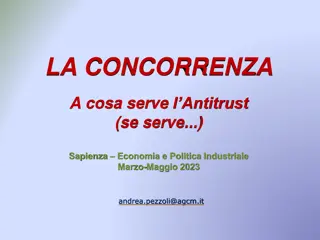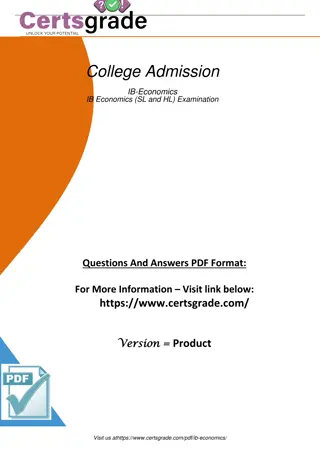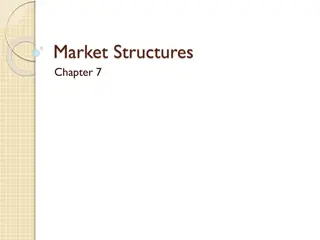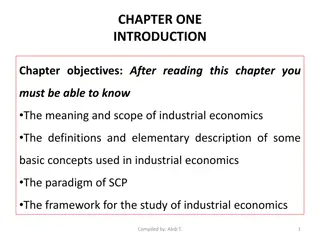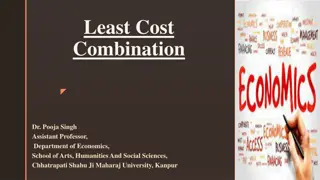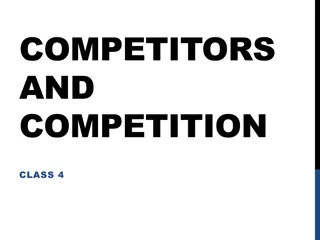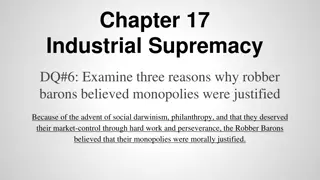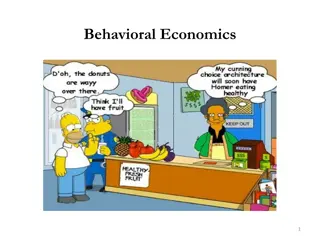Understanding Monopolies in Economics
Monopolies are considered inefficient because they can earn long-term profits. In a monopoly equilibrium, the relationship between price, marginal revenue, and marginal cost differs. Natural monopolies can supply goods at lower costs. Compared to perfectly competitive firms, monopolies charge higher prices. Analyzing demand curves for monopolies can determine optimal production levels and pricing strategies to maximize profits.
Download Presentation

Please find below an Image/Link to download the presentation.
The content on the website is provided AS IS for your information and personal use only. It may not be sold, licensed, or shared on other websites without obtaining consent from the author. Download presentation by click this link. If you encounter any issues during the download, it is possible that the publisher has removed the file from their server.
E N D
Presentation Transcript
Economists consider monopolies to be inefficient because they can earn profits in the long run. A. True B. False
In equilibrium, the relationship between price (P), marginal revenue (MR), and marginal cost (MC) for a monopoly is: P < MR = MC. A. True B. False
A natural monopoly can supply a good to the entire market at a lower cost than two or more firms could. A. True B. False
In comparison to a perfectly competitive firm, a monopolist charges a A. higher price and produces a higher quantity. B. higher price and produces a lower quantity. C. lower price and produces a higher quantity. D. lower price and produces a lower quantity.
Refer to the table which illustrates the demand curve for a monopolist. Suppose the firm s marginal cost is constant at $5, and there are no fixed costs. This monopolist will produce A. 5 units of output and charge a price of $10. B. 4 units of output and charge a price of $12. C. 3 units of output and charge a price of $14. D. 2 units of output and charge a price of $16.
Refer to the table which illustrates the demand curve for a monopolist. Suppose the firm s marginal cost is constant at $5, and there are no fixed costs. By producing the profit- maximizing output, this monopolist will earn total profits of A. $12. B. $27. C. $28. D. $37.
Suppose that a monopolist is producing a level of output such that marginal revenue exceeds marginal cost. To increase profits, this monopolist should A. increase output and increase price. B. decrease output and decrease price. C. increase output and decrease price. D. decrease output and increase price.
Refer to the figure. This monopolist will charge a price of: A. P5and produce quantity Q3 B. P2and produce quantity Q2 C. P1and produce quantity Q1 D. P3and produce quantity Q2
Refer to the figure. The deadweight loss for a profit-maximizing monopolist is the area ________, and the profit per unit is the distance______. A. ABEG; AF. B. ABC; AG. C. FBE; FE. D. GEC; BE.
Perfect price discrimination A. raises profit. B. raises total surplus. C. lowers consumer surplus. D. All of the above are correct.
Which of the following is not an example of price discrimination? A. Nabisco provides cents-off coupons for Oreos. B. Amtrak offers a lower price for weekend travel compared to weekday rates on the same routes. C. Hotel rates are lower for AAA members than for nonmembers. D. Lamb s wool sweaters are less expensive than cashmere sweaters.
When a movie theater offers a discounted ticket price to moviegoers over the age of 65, it engages in A. price discrimination and increases the deadweight loss. B. price discrimination and decreases the deadweight loss. C. revenue maximization and decreases the deadweight loss. D. perfect price discrimination and decreases the deadweight loss.
If regulators had not approved mergers in the past decade between major networked airlines, travelers would be better off today. A. agree B. disagree C. uncertain


